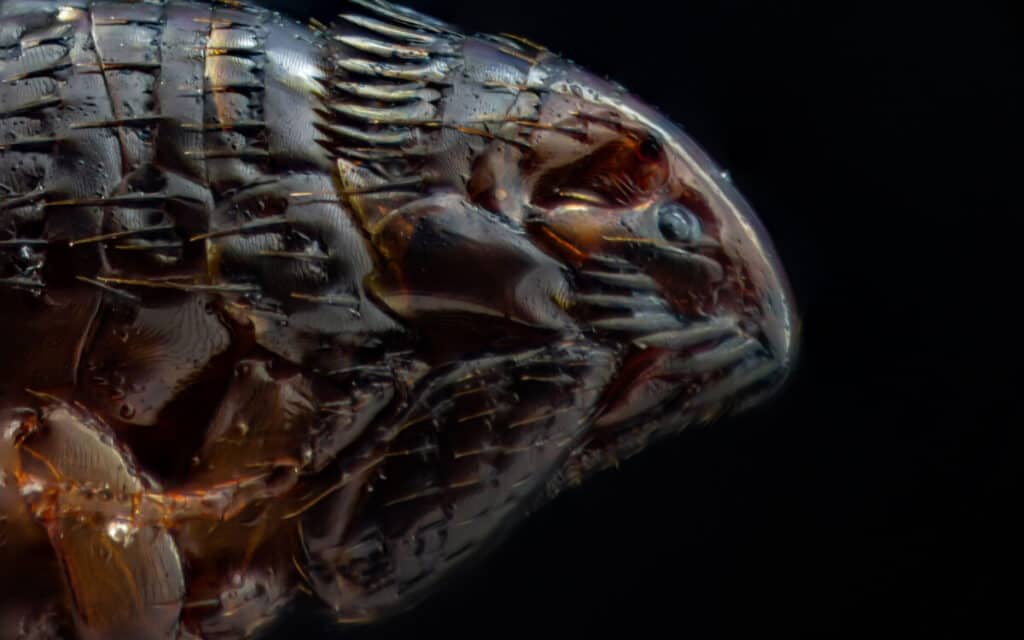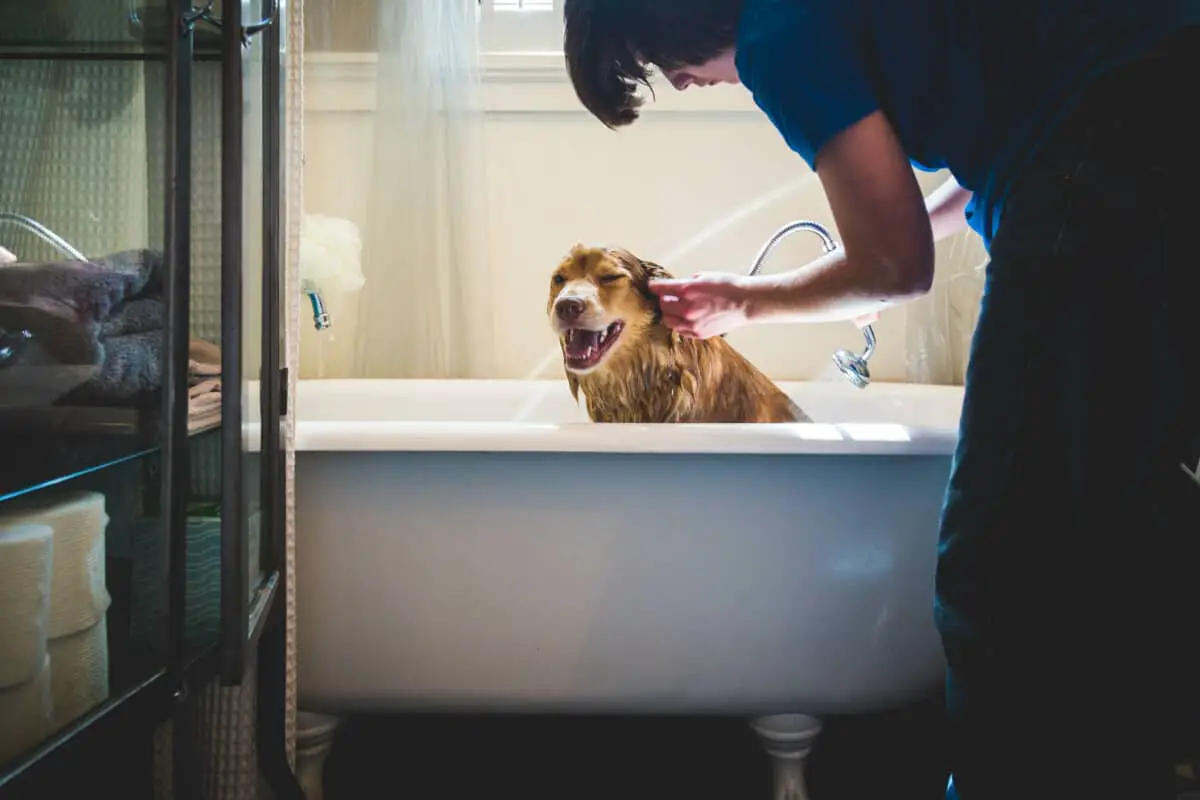Affiliate Disclosure: This post may contain affiliate links. If you make a purchase after clicking on these links I will be compensated at no extra cost to you. However, I never recommend anything I don’t love or wouldn’t use myself!
Yes, fleas drown in water, however, they are extremely difficult to drown if only water is used. Fleas can float on the water’s surface and even a fully submerged flea can survive up to 24 hours. Therefore a combination of water with soap or shampoo is required to drown fleas effectively.
If fleas have found their way into your home, there is no time to waste. In this article, you will learn about how water affects fleas and how to best utilize water in the fight against fleas.
Why Are Fleas So Difficult to Drown?
While drowning your pet’s fleas in water does seem like an obvious solution, it’s not quite that simple. Fleas have been around for millions of years, and their long history has given them plenty of time to adapt and evolve for survival.
Fleas, as well as many other insects, have a naturally secreted waxy layer around their body that repels water.
This oil-like coating makes fleas harder to kill, but it also helps fleas move more easily through their host’s hair.
Along with water’s high surface tension, this waxy exterior allows fleas to float on the surface with ease. But what happens if a flea is fully submerged below the water’s surface?
It’s thought that fleas’ wax cuticles likely cover a portion of the trachea. This waxy portion means that even if a flea is submerged, water is prevented from fully entering and destroying its respiratory system.
If a flea has been fully submerged underwater anywhere up to 24 hours, it can revive once dried out.
Are Flea Eggs Waterproof?
Unfortunately, adult fleas are not the only water-resistant part of the life cycle. Their eggs are too!
Flea eggs have a protective membrane inside their shells that allows oxygen to pass through but keeps water out.
How Long Can Fleas Survive in Water?
Researchers have found that when simply dropped into water, fleas can survive for extremely long periods.
On the water’s surface, a flea can easily survive for up to a week and a flea that has been fully submerged in water can still survive up to 24 hours.
Since a flea only has a lifespan of about 100 days, this means it could spend anywhere between 1-7% of its life in water without dying!
Not only can a flea survive underwater, but it can live without food for several months! Be careful to properly dispose of fleas to avoid any of them reviving and returning to your animal.
Can Fleas Swim?

No, fleas cannot swim. If fleas are dropped into water they may appear to swim, however, they are in fact just flailing. This is because their waxy exterior along with water surface tension keeps them afloat. Removing their waxy coating and water tension will cause a flea to sink.
So while fleas that get dropped into water float around, they have no control over the direction they’re headed in. They tend to just drift aimlessly until they find a dry surface to jump from and escape.
This is why you will need to take further action to prevent fleas from escaping back into your home and possibly reinfesting your pet.
How to Drown Fleas at Any Point in Their Life Cycle
As we’ve now covered, drowning fleas in water alone is not really a viable solution for ridding your pet and your home from an infestation. However, there is still hope for this method.
The best way to drown fleas is to add some dish soap or shampoo to the water. These products strip fleas of their waterproof coating and contain surfactants that reduce water surface tension. The combination of these effects enables fleas to drown far more quickly than water alone.
This will kill fleas at any point during their lifecycle so you do not need to worry about, fleas, larvae, or eggs.
Drowning Fleas on Your Pet
As we learned above, plain water is not enough to kill fleas. Instead, you need to use water and some form of soap.
Pets’ fur has its own protective coat of natural oils. While dish soap is great for killing fleas, it is also very effective at removing pets’ protective oils.
Without these protective oils, your pet’s skin will dry out and get irritated, which could eventually lead to an infection.
To drown fleas on your pet, use a mild soap or shampoo specifically designed for pets. This will enable fleas and their eggs to become fully wettable and will remove and drown them more rapidly.
If you want to go a more natural route, there are natural-based shampoos you can use too.
While you can get shampoos specifically designed for fleas, typically anything that produces a lather will kill them off.
The main benefit of using a flea shampoo is that it will usually contain scents that also help to repel fleas later on.
However, by far the most effective way to repel fleas without a prescription is to use a topical or spot-on flea treatment such as Frontline (view on Amazon).
Just wash the fleas off and then apply a topical treatment to prevent any fleas from returning for at least a month.
If you do not want to go down the route of using a topical treatment, the Center for Disease Control recommends repeating the flea removal process within ten days of the first scrubbing.
Drowning Fleas When Flea Combing

If you have an extremely young pet that is too young to be bathed, (less than around 8 weeks) or if you simply prefer this method, you can try to use a flea comb to remove fleas.
You will need to kill any fleas that you remove to prevent them from escaping back into the house and re-infesting your pet later on.
Have a bowl or tray of soapy water nearby. As you find any fleas or eggs, drop them into the bowl of soapy water to drown them. If you want to be sure that the fleas do not escape, you can also line the edge of the bowl or tray with petroleum jelly.
As we discussed earlier, the fleas will continue to flail in the water until they reach a dry area where they can escape. Lining the edge of the bowl with petroleum jelly will prevent them from doing so.
Alternatively, rather than using a bowl of water, you can use a bowl of vegetable oil. Because vegetable oil has less surface tension than water, the fleas will sink in it faster.
Additionally, oil is more viscous than water and therefore more difficult for them to escape.
Drowning or Killing Fleas in Bedding and Upholstery
Be Sure to Treat Your Carpets Too!
Many pet owners use Diatomaceous Earth to treat carpets and even areas outdoors. This is a white powder made up of fossilized diatoms.
Diatoms are small aquatic animals whose bones contain silica. This substance lacerates fleas’ exoskeletons and dehydrates them.
This can be effective, but it’s also quite messy which is why I prefer to go down the vacuuming route.
Drowning Fleas Around the Home
Fleas are attracted to warmth and light. You can use this to your advantage and set up a flea trap.
Place a lamp over a tray or dish full of soapy water, with the light directed downwards into the tray or dish. Lamps that produce a little heat work even better as they simulate the warmth of a warm-blooded mammal. Fleas will be attracted to the light and will jump into the soapy water and drown.
The following video uses a similar method with flashlights and clear bottles. You can watch it to see how the water tray trap works!
Just like earlier, you can line the edge of the tray with petroleum jelly to further reduce the chance of fleas escaping the trap.
You do not have to sit around waiting for fleas to find their way into your home before you can fight them. Prevent fleas in the first place by following the steps in the following section.
Other Methods to Prevent Fleas
There are many different ways to prevent fleas from finding a way into your home. While implementing every method would be best, accomplishing several of the following flea prevention tactics should be enough to protect your home and pets.
The Center for Disease Control has several suggestions to prevent fleas from finding their way onto your pets.
Reduce the amount of time your pet spends outdoors. The longer your pet spends outside, the greater their chance of catching fleas is.
Regardless of how much time your pet spends outside, check them for fleas frequently. If you find a flea before it can lay and hatch eggs, you can reduce the chance of a more severe outbreak.
When checking your pet for fleas, search the following areas as they tend to favor these areas the most:
- Where the tail and the hips meet
- Where the neck and the shoulders meet
- The back of the hind legs
- The underside near the groin and belly
In addition to checking for fleas regularly, you should bathe and brush your pet often. Only use shampoos or natural remedies designed for your pet. To prevent the natural oils in your pet’s fur from being removed, veterinarians do not suggest bathing them more than once a month (unless necessary, of course).

You can further prevent fleas from entering your home by making it an undesirable environment. Mop floors and wash baseboards with citrus-scented detergent. Fleas, like many other insects, do not like the smell of citrus. Areas treated with citrus will repel fleas.
As well as preventing fleas inside your home, the Center for Disease Control encourages pet owners to prevent fleas from even entering their yards.
You can prevent fleas from entering your yard the same way you would in your home: by making it an undesirable environment. Fleas prefer to live in shady, humid areas. If your yard does not meet these characteristics, the fleas will probably choose to live somewhere else.
Methods for Preventing Fleas Outdoors
Mow your lawn frequently. Tallgrass creates the perfect shady environment for fleas to flourish. Mowing your grass regularly allows plenty of sunlight to penetrate the greens and keeps fleas away.
Another lawn care technique is to avoid overwatering. While we all want beautiful green grass, overwatering could encourage fleas to call your yard home.
Remove any debris in your yard. Such rubble might include leaves, branches, rock piles, wood stacks, etc. Garbage and debris in the yard not only encourage fleas to enter your yard, but it encourages flea-carrying animals too. Rodents such as mice and opossums are notorious for carrying fleas, as well as other diseases. It is crucial to keep these animals away for both you and your pets.
You can prevent rodents and wild animals from wandering into your yard by storing garbage securely and never leaving food out. Seal any holes that might be allowing rodents into your yard or home.
In addition to rodents and opossums, stray animals tend to carry fleas. Do not feed your pets outdoors, as this could encourage wild animals to linger around these areas.
Flea prevention should not take place solely during the warm months of the year. While cold temperatures kill fleas, some fleas can escape the dropping digits and survive year-round on your pet. Always work to prevent fleas, even during the colder months of the year.
If you follow these steps for preventing fleas, there is a much better chance that you and your pets will be able to enjoy a flea-free life!

